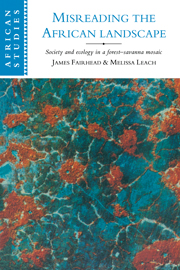Book contents
- Frontmatter
- Contents
- List of plates
- List of figures
- List of tables
- Note on authorship and research collaboration
- Acknowledgements
- Linguistic conventions
- Introduction
- 1 Convictions of forest loss in policy and ecological science
- 2 Forest gain: historical evidence of vegetation change
- 3 Settling a landscape: forest islands in regional social and political history
- 4 Ecology and society in a Kuranko village
- 5 Ecology and society in a Kissi village
- 6 Enriching a landscape: working with ecology and deflecting successions
- 7 Accounting for forest gain: local land use, regional political economy and demography
- 8 Reading forest history backwards: a century of environmental policy
- 9 Sustaining reversed histories: the continual production of views of forest loss
- 10 Towards a new forest–savanna ecology and history
- Appendix I Glossary of plant names
- Appendix II Cassette recordings of oral accounts and discussions
- Notes
- List of references
- Index
- Titles in the series
- Plate section
1 - Convictions of forest loss in policy and ecological science
Published online by Cambridge University Press: 05 June 2012
- Frontmatter
- Contents
- List of plates
- List of figures
- List of tables
- Note on authorship and research collaboration
- Acknowledgements
- Linguistic conventions
- Introduction
- 1 Convictions of forest loss in policy and ecological science
- 2 Forest gain: historical evidence of vegetation change
- 3 Settling a landscape: forest islands in regional social and political history
- 4 Ecology and society in a Kuranko village
- 5 Ecology and society in a Kissi village
- 6 Enriching a landscape: working with ecology and deflecting successions
- 7 Accounting for forest gain: local land use, regional political economy and demography
- 8 Reading forest history backwards: a century of environmental policy
- 9 Sustaining reversed histories: the continual production of views of forest loss
- 10 Towards a new forest–savanna ecology and history
- Appendix I Glossary of plant names
- Appendix II Cassette recordings of oral accounts and discussions
- Notes
- List of references
- Index
- Titles in the series
- Plate section
Summary
Visions of forest loss
Guinée's present national forestry plan suggests that Kissidougou's landscape is degrading fast:
The opinion, quasi-general, is that … the areas … north of Macenta, Gueckedou, Kissidougou will soon be no more than a vast poor savanna, the [forest] islands and gallery forests still present at risk of being rapidly destroyed.
(République de Guinée 1988: 31)A French forestry advisory team describes the forest which policy-makers consider to have been lost:
The region of Kissidougou was covered by a deciduous forest of Khaya sp., Chlorophora sp., Antiaris africana, Afzelia africana, Ceiba pentandra, Triplochiton scleroxyllon …
(Estève et al. 1989: 181)Many modern studies which have informed environmental and rural development projects in the region think that this extensive forest cover has been lost within the past 50 years; within the lifetime of the region's present inhabitants. Thus we read that:
Around 1945, the forest, according to the elders, reached a limit 30 km north of Kissidougou town. Today, its northern limit is found at the level of Gueckedou- Macenta, thus having retreated about 100 km … This deforestation is essentially the result of human action.
(Ponsart-Dureau 1986: 9–10)Or:
In the green belts which surround the villages, one finds the relics of original primary forests. The value of these biotypes in the heart of a nearly 100% degraded environment is inestimable. One finds no individual of [characteristic savanna tree species] more than 35 years old … supporting the thesis that the site has burned systematically only since then.
(Green 1991: 10–11)- Type
- Chapter
- Information
- Misreading the African LandscapeSociety and Ecology in a Forest-Savanna Mosaic, pp. 24 - 54Publisher: Cambridge University PressPrint publication year: 1996



